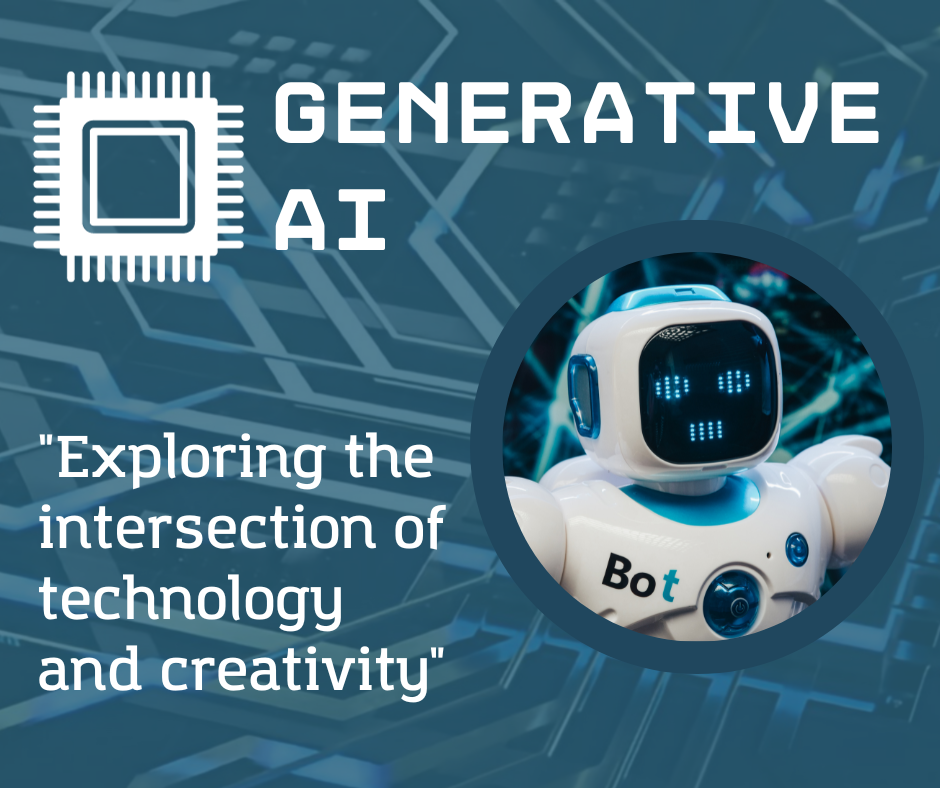Generative AI vs. ChatGPT – in the dynamic world of artificial intelligence, this comparison is essential. These two technologies, while closely related, serve distinct purposes, each with unique capabilities and applications. In this blog, we dive into the distinction between Generative AI and ChatGPT, exploring their functionalities, applications, and impact across industries.
Artificial Intelligence (AI) has made remarkable strides in recent years, and one of the most exciting developments is generative AI. Among the various applications of generative AI, ChatGPT has gained considerable attention for its ability to generate human-like text and engage in meaningful conversations. In this blog, we will delve into the distinction between generative AI and ChatGPT, exploring their respective functionalities, applications, and the impact they have on various industries.
Generative AI: A Brief Overview
Generative AI is a subset of artificial intelligence that focuses on creating data or content, typically in the form of text, images, audio, or even video. It involves training models on large datasets and enabling them to generate new content that is coherent and contextually relevant. Generative AI models are capable of creative tasks such as text generation, image synthesis, and even music composition.
Common Generative AI Models

Certainly, let’s expand on each of the mentioned generative AI models:
Recurrent Neural Networks (RNNs):
These foundational models for text generation are akin to the building blocks of generative AI. RNNs possess a unique ability to process sequences of data, making them well-suited for tasks like language modeling and text generation. They operate by maintaining an internal memory that captures information from previous time steps, which is then used to influence the output at the current step. However, RNNs have their limitations, such as difficulties in capturing long-range dependencies in text due to the vanishing gradient problem.
Generative Adversarial Networks (GANs):
GANs introduce a fascinating concept of competition within AI. This architecture comprises two neural networks: a generator and a discriminator. These two networks engage in a competitive process where the generator tries to create data that is indistinguishable from real data, while the discriminator’s task is to differentiate between real and generated data. As they improve over time, GANs can generate incredibly realistic data, making them particularly valuable for tasks like image generation, style transfer, and even generating lifelike faces.
Transformer-based Models:
Among the recent advancements in generative AI, the Transformer architecture has played a pivotal role, with models like GPT (Generative Pre-trained Transformer) leading the way. These models have brought about a revolution in the field. Unlike RNNs, Transformers do not rely on sequential processing, which allows them to capture long-range dependencies and contextual information more effectively. They operate by attending to all positions in the input sequence simultaneously, making them highly efficient. GPT, in particular, is pre-trained on massive datasets and can generate coherent and contextually relevant text, making it a preferred choice for a wide range of natural language processing tasks, from text generation to language translation.
ChatGPT: The Conversational AI
ChatGPT is a specific implementation of generative AI, designed for engaging in text-based conversations. It is built upon the GPT architecture but fine-tuned to produce more coherent and contextually appropriate responses in a conversational context. ChatGPT is trained on a diverse range of texts, allowing it to generate human-like responses and understand context.
Key Features of ChatGPT
Some of the key features of ChatGPT are as follows:
Natural Language Understanding:
ChatGPT’s prowess in natural language understanding goes beyond mere comprehension. It can decipher nuances in language, including colloquialisms, idioms, and even humor. This ability allows ChatGPT to engage in a wide range of conversational tasks, from answering factual questions to providing emotional support or generating creative content.
Contextual Awareness:
What truly sets ChatGPT apart is its remarkable contextual awareness. It doesn’t treat each user query in isolation but remembers the ongoing conversation. This memory allows ChatGPT to provide responses that are contextually relevant, ensuring that interactions feel more human-like and coherent. It can seamlessly switch between topics, maintaining the flow of conversation.
Customization:
ChatGPT is not a one-size-fits-all solution. It can be fine-tuned to cater to specific applications and industries. For instance, in the realm of customer support, businesses can train ChatGPT to understand their products, policies, and customer inquiries. This customization ensures that ChatGPT aligns perfectly with the goals and needs of various businesses and organizations.
Multilingual Capabilities:
In a globalized world, linguistic diversity is the norm. ChatGPT rises to the occasion with its multilingual capabilities, making it accessible and adaptable across borders and cultures. Whether it’s assisting tourists in foreign countries or facilitating cross-border business communication, ChatGPT can converse fluently in multiple languages, eliminating language barriers.
Also read : “Exploring the Power of Generative AI: What Is It and Why Is It So Popular? How Can You Use It?“
Applications of Generative AI
Generative AI has a wide range of applications across industries:
Content Generation:
Generative AI’s prowess in content creation extends to various digital platforms, making it an indispensable tool for content creators. Here are some key aspects of its role in content generation:Website Content:
Generative AI can automatically produce website content, including product descriptions, FAQs, and landing page copy. This not only saves time but also ensures a consistent tone and quality.Blogs:
Bloggers and online publications benefit from generative AI by using it to generate topic ideas, outlines, and even drafts. Writers can then focus on refining the content rather than starting from scratch.Social Media:
Managing multiple social media profiles can be time-consuming. Generative AI can assist in creating engaging social media posts, including captions, hashtags, and even graphics, streamlining the content creation process.
Creative Arts:
Generative AI’s foray into the world of creative arts has been nothing short of revolutionary. Artists and musicians are leveraging its capabilities to explore new dimensions of creativity:Art Generation:
Generative AI algorithms, such as those based on GANs, have produced stunning visual art pieces, some of which have even been auctioned for substantial sums. Artists use these algorithms to inspire and enhance their work.Music Composition:
Composers and musicians collaborate with generative AI to compose music that blends traditional compositions with modern, AI-generated elements. This fusion of creativity opens up novel avenues for musical expression.
Language Translation:
Generative AI’s language translation capabilities have had a profound impact on breaking down language barriers and enabling seamless communication:Real-Time Translation:
Travelers, businesses, and individuals communicating across borders benefit from real-time translation services powered by generative AI. This technology facilitates smoother interactions in a globalized world.Cultural Exchange:
Language is a gateway to culture. Generative AI’s translation abilities foster cultural exchange by allowing people to explore literature, films, and conversations in languages they may not be proficient.
Data Augmentation:
In the field of data science, generative AI plays a pivotal role in enhancing the quality and quantity of data for machine learning models:Synthetic Data Creation:
Generative AI generates synthetic data that mimics real-world datasets. This synthetic data is used to supplement existing datasets, particularly in cases where collecting more real data is impractical or costly.Model Training:
Machine learning models rely on data to learn and make predictions. Generative AI assists in training these models effectively, leading to improved accuracy and performance in various applications, from image recognition to natural language processing.
Applications of ChatGPT

ChatGPT’s ability to engage in natural language conversations has unlocked a wealth of possibilities across multiple domains. Here are some of the key applications:
Virtual Assistants:
ChatGPT serves as the digital backbone for virtual assistants that offer support and assistance in real-time. These assistants can be integrated into websites or applications, enhancing user experiences and streamlining customer support.Content Recommendations:
ChatGPT’s natural language processing capabilities enable it to understand user preferences and queries. This knowledge can be leveraged to provide personalized content recommendations, whether it’s suggesting articles, products, or services that align with users’ interests.Language Learning:
Language learners can benefit significantly from ChatGPT’s conversational abilities. By engaging in practice conversations in a foreign language, users can improve their speaking and comprehension skills. This application extends beyond individuals to language learning platforms and apps.Medical Consultations:
In the healthcare sector, ChatGPT plays a vital role in assisting both medical professionals and patients. It can provide accurate information on medical conditions, treatment options, and medication details. Additionally, it can answer common medical queries, freeing up healthcare providers’ time for more critical tasks.Education and Tutoring:
ChatGPT can serve as an AI-powered tutor, offering explanations, solving problems, and assisting with homework in various subjects. This application extends from primary education to higher education and professional training.Content Generation:
ChatGPT’s conversational abilities can be harnessed for content creation tasks, including drafting emails, writing reports, or generating marketing copy. It serves as an intelligent writing assistant, saving time and enhancing the quality of written materials.Therapeutic Conversations:
In the field of mental health, ChatGPT can provide a platform for therapeutic conversations. It can offer emotional support, guide users through self-help exercises, and even monitor mental health trends.
Emerging Horizons: Generative AI and ChatGPT in 2023
In the past year, generative AI and ChatGPT have made significant progress. For example, generative AI models have been developed that can create realistic images and videos, and ChatGPT has been improved to be more informative and comprehensive in its responses.
These advances are opening up new possibilities for the use of generative AI and ChatGPT. For example, generative AI could be used to create new virtual worlds for video games and movies, and ChatGPT could be used to develop more personalized and engaging educational experiences.
As generative AI and ChatGPT continue to develop, they are likely to have a major impact on many industries and aspects of our lives.
Conclusion
Generative AI and ChatGPT represent exciting advancements in artificial intelligence, with the former focused on creating diverse content and the latter specializing in text-based conversations. Understanding the distinction between these technologies is crucial for harnessing their potential across various industries. As both generative AI and ChatGPT continue to evolve, we can expect even more sophisticated applications that enhance our daily lives and transform the way we interact with technology.

























